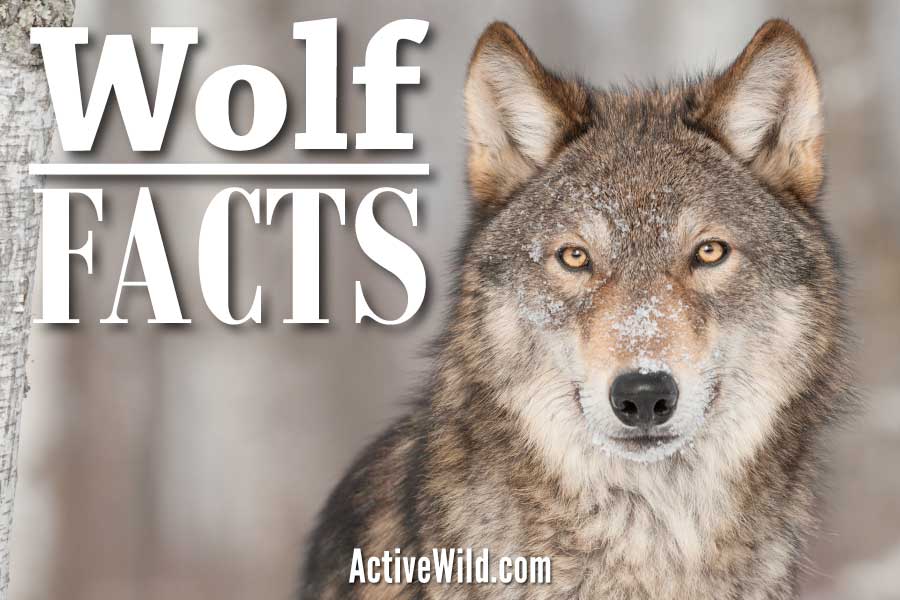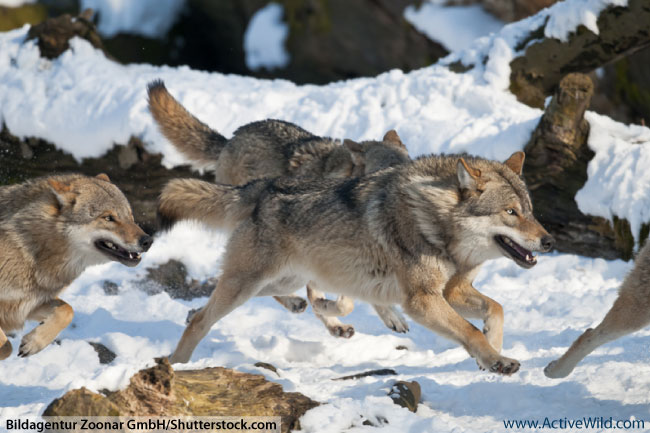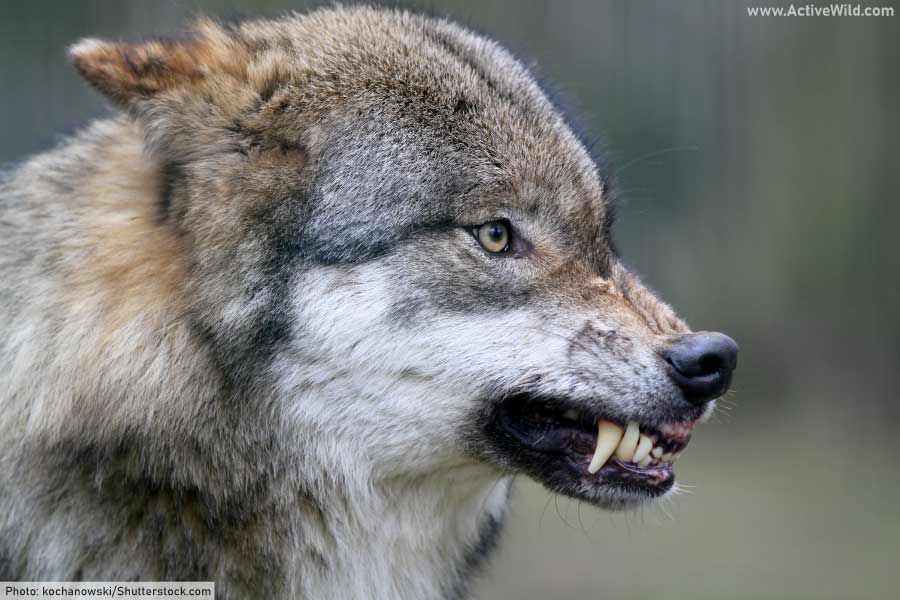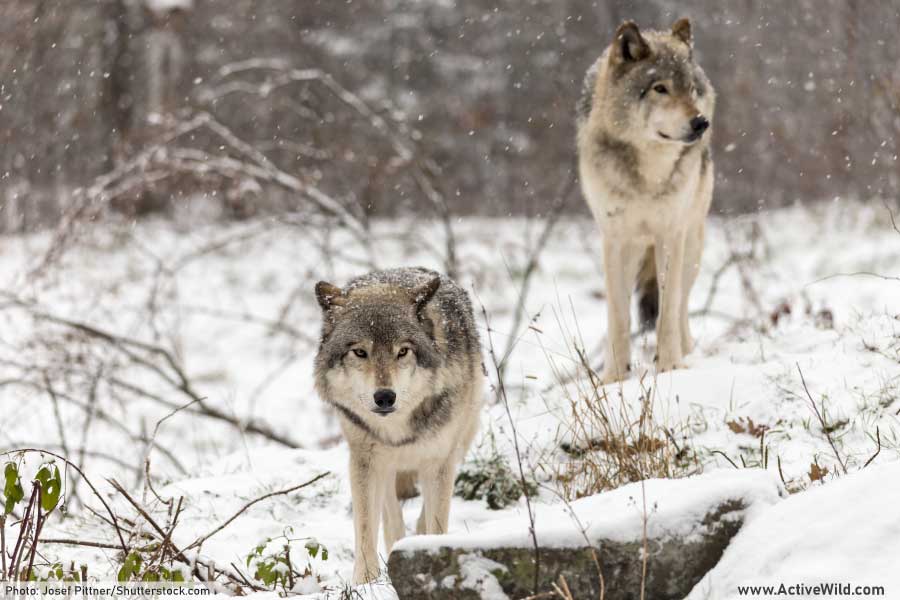Gray wolf facts, pictures and information: discover the characteristics, behavior and ecology of one of the world’s best-known predators...
Gray Wolf Facts: Page Index
Other Wolf Pages on Active Wild
- Wild Dog Species List: All Types Of Wild Dogs, With Pictures & Information
- Red Wolf Facts, Pictures & Information. Complete Guide To This Critically Endangered U.S. Mammal
- Eurasian Wolf Facts For Kids & Adults: Pictures, Information & Video
- Fun Facts On Dogs: Discover Interesting Facts About Domestic & Wild Dogs
- Dire Wolf Facts for Kids & Adults, With Pictures & In-Depth Information
What is a Gray Wolf?
The gray wolf (grey wolf in British English) is the largest member of the dog family Canidae, and one of the most widespread. With its shaggy, variegated coat and large, intelligent eyes, the species is an iconic predator of the Northern Hemisphere.
The gray wolf’s name is often shortened to just ‘wolf’; whenever you hear someone talking about a ‘wolf’, they’ll almost certainly be referring to the gray wolf.
The gray wolf’s scientific name is Canis lupus.
A highly adaptable animal, the gray wolf can be found in habitats ranging from the Arctic tundra of the far north to the deserts of the Arabian Peninsula.
Wolves are famous for being fearsome hunters, but an individual wolf is actually not so formidable; when it comes to strength, speed, and stealth, wolves can’t compete with wild cats like cougars. But wolves have something few cats have: a pack.
More than any other land carnivore, wolves specialize in coordinated attacks. That allows them to take down large prey, such as the American bison, that no other predator would challenge.
Over its wide range, the gray wolf has diversified into a huge variety of different types, and now there are some 30 recognized subspecies of Canis lupus, each of which corresponds to a different region and habitat.
The most widespread subspecies, and the first to be scientifically recognized, is Canis lupus lupus, the Eurasian wolf.
Human hunting has more or less eliminated the Eurasian wolf from its former range in Western Europe, but it still roams free across Eastern Europe, Siberia, and all the way to the border of China.
- You can find out more about the Eurasian wolf on this page: Eurasian Wolf Facts
The largest gray wolf is the Alaskan timber wolf Canis lupus occidentalis. With the largest individuals reaching 150 lbs., they outweigh all but the largest domestic dog breeds.
The Greenland wolf Canis lupus orion lives in unimaginable cold at the remote northern end of Greenland. Little is known about this subspecies, chiefly because their habitat is difficult for scientists to reach and study in.
By far the most well-known wolf subspecies is Canis lupus familiaris, the domestic dog. Dogs were once placed in their own species, Canis familiaris, but scientists now realize that the domestic dog is simply a subspecies of the gray wolf.
Over thousands of years of selective breeding, domestic dogs have developed a huge variety of body types, whereas natural selection has kept all wild wolves looking fairly similar to one another. But at the genetic level wolves and dogs remain extremely close.
- You can find out more about dogs on this page: Fun Facts on Dogs
The gray wolf is a close cousin of the coyote, Canis latrans – so close, in fact, that scientists disagree about whether coyotes should be counted as a separate species or merely a small-bodied subspecies of Canis lupus.
- You can find out more about coyotes on this page: Coyote Facts
Gray Wolf Behavior & Life Cycle
The iconic image of the gray wolf is of a lone individual with its muzzle in the air, howling under a full moon. In reality, howling has nothing to do with the moon. It’s just a long-range communication method that packs use to mark their territory, coordinate their movements, or prepare for a hunt.
A wolf’s howl can carry as far as seven miles.
Like humans, wolves use complex forms of communication to maintain the stability of their large social groups. In addition to howls, they use a variety of vocal calls including barks, growls, and yelps. They also communicate by scent and body language.
One of the most important tasks for any wolf is to figure out its place in the dominance hierarchy. Wolf packs have an alpha male and alpha female, and typically no one else in the pack is allowed to breed.
Dominance fights can be lethal, but usually the combatants try to avoid injuring one another. They use growls and threat displays to show their strength, and usually the weaker wolf submits before any actual fighting begins.
The submissive wolf will roll on its back, making itself vulnerable and effectively saying “I give up – I don’t want to fight you.”
In order to reproduce, a young wolf has a few options. They can stay in the group where they were born and try to become the alpha. They can strike out on their own, looking for an unoccupied territory and a mate from another pack. Or they can migrate into a new group and try to take it over. The last option is extremely risky, since wolves regularly kill outsiders who try to join their groups.
Each spring, the alpha male and female produce a single litter of 4-6 pups. That timing gives the pups the best opportunity to reach their adult size before the lean months of winter roll around again.
Before giving birth, the mother finds a spot for a den, often in the hollow of a tree’s roots, where she digs out a safe place for the pups.
Pups are born completely helpless and have to stay in the den for the first few weeks, where they are nursed by their mother. By eight weeks, the pups can leave the den and eat meat given to them by adults in the pack.
Wolf packs vary in size based on individual behavior and local ecological conditions.
The largest known wolf pack is Yellowstone National Park’s Druid Pack, which produced several large litters in the late 90s and grew to a total of 37 members at its peak.
It’s hard to imagine what it would have been like for the elk and deer in the Druid Pack’s territory, being hunted by a pack that size!
Wolves can hunt just about any animal that lives near them: elk and white-tailed deer are particularly abundant in northern North America, and are therefore the preferred targets of local wolf packs.
Wolves have also been known to take on larger prey, including bison and moose. That takes more coordination and involves more risk, but also yields a larger amount of meat from a single kill.
Wolf packs often specialize in a single type of prey. By concentrating on one species, the pack can develop effective strategies and become more efficient at hunting their target animal.
Pups learn those techniques as they grow, so prey specialization gets passed down as part of the pack’s cultural heritage.
Gray Wolf Ecology
Gray wolves aren’t picky about climate. They can tolerate extreme cold in northern Greenland and brutal heat in the Arabian peninsula.
Some wolves inhabit dense forests, while others are adapted to open grasslands and deserts. As long as there are large herbivores for them to hunt, wolves can establish a population.
For all their adaptability, though, there’s one thing that wolf populations can’t withstand: persecution from humans.
Historically, wolves have been seen by humans as evil, bloodthirsty villains, and as a result have been deliberately persecuted out of a perceived need for self-defense.
In fact, wolf attacks on humans are extremely rare–the real danger is not to human lives, but to their livestock. Goats, cows, and pigs are ideal prey for wolves because of their docile nature and high density in pens. For ranchers and farmers in wolf country, this can be a real problem.
In the past, wolf hunting was the most effective way of mitigating those losses, but today there are nonlethal options, such as air cannons and other noisemakers, that can discourage a wolf pack from targeting livestock.
Recently, farmers in Wisconsin experimented with shock collars – wolves were trapped and fitted with collars that gave a painful shock if the wolf got too near a farm. The technique proved to be 100% effective, but is hard to implement because it requires trapping the wolves.
Although they pose a problem for farmers, gray wolves are essential to native ecosystems all over the Northern Hemisphere. They are a “keystone species,” meaning their ecological role is so critical that their removal can cause a complete collapse of local biodiversity.
Over the last few decades, scientists have had the opportunity to observe that effect directly thanks to wolf reintroduction programs in the northern United States.
In Yellowstone National Park, wolves were reintroduced in 1995 and scientists watched as the new top predator rapidly transformed the park’s ecosystem.
The main ecological effect of wolves is that they control the population of large ungulates (hoofed animals), especially deer and elk.
Without wolves to keep their population down, elk herds grow exponentially and put unsustainable pressure on the local plant life.
Since plants are the foundation of most ecosystems, their destruction triggers an ecological meltdown. Therefore, wolves protect the forests and prairies by reducing the number of large herbivores.
In addition to their direct effect on deer and elk populations, wolves also affect the behavior of their prey animals.
Scientists have demonstrated that top predators create an “ecology of fear,” where prey species spend less time eating and more time looking around for predators.
So not only are there fewer herbivores, but the remaining herbivores are less voracious than they would be without wolves.
The ecology of fear also has spatial effects: the so-called “landscape of fear,” where herbivores avoid areas they perceive as more dangerous.
In a major study of wolves and elk in Yellowstone, ecologists demonstrated that the presence of wolves caused elk to spend less time browsing near rivers, which are favorite areas for wolves to hunt.
By shifting herbivore activity away from the rivers and streams, the wolves protect the especially vulnerable riparian forest. With more plant life thriving on the banks, the waterways are protected from erosion and shaded from the sun, creating cool, clear water: exactly the conditions needed for fish like trout.
Meanwhile, the trees provide a habitat for birds and any number of insect species that need to live near fresh water. So, the wolf’s ecological impact goes far beyond the direct reduction of prey numbers.
Wolves also provide meat for other, smaller predators. When a wolf pack makes a kill, the wolves get the choice cuts of meat, but they always leave scraps behind. When the wolves move on, the carcass becomes a feast for eagles, magpies, and coyotes.
Further Reading & References
Other Wolf Pages on Active Wild
- Wild Dog Species List: All Types Of Wild Dogs, With Pictures & Information
- Dire Wolf Facts for Kids & Adults, With Pictures & In-Depth Information.
- Red Wolf Facts, Pictures & Information. Complete Guide To This Critically Endangered U.S. Mammal
- Eurasian Wolf Facts For Kids & Adults: Pictures, Information & Video
- Fun Facts On Dogs: Discover Interesting Facts About Domestic & Wild Dogs
References
- The International Wolf Center (source)
- Living With Wolves Interactive Online Exhibit (source)
- Yellowstone Wolves, A Fandom page tracking the lives of the Yellowstone wolves (source)
- Laundré, John W., Lucina Hernández, and William J. Ripple. "The landscape of fear: ecological implications of being afraid." The Open Ecology Journal 3.1 (2010).









